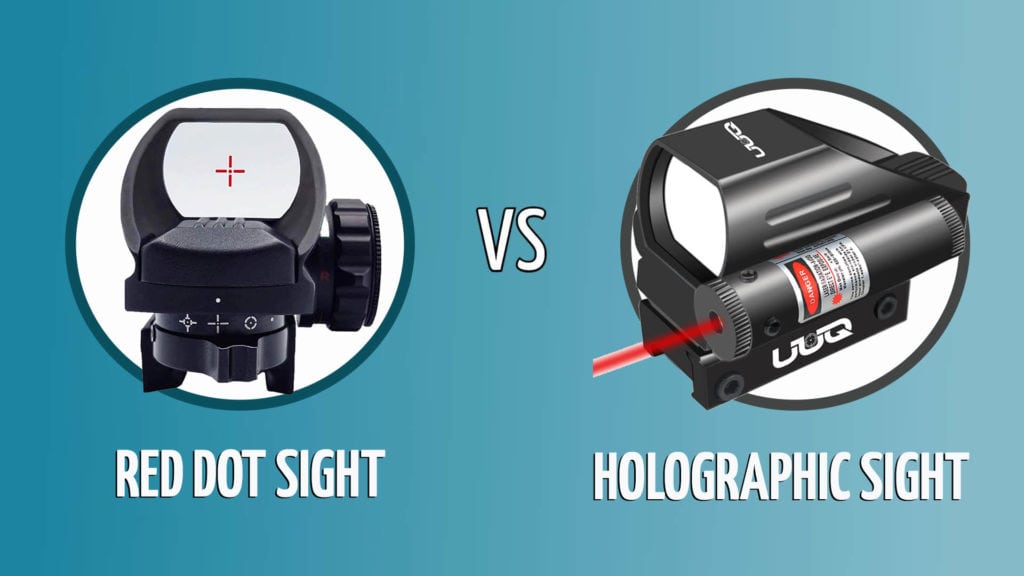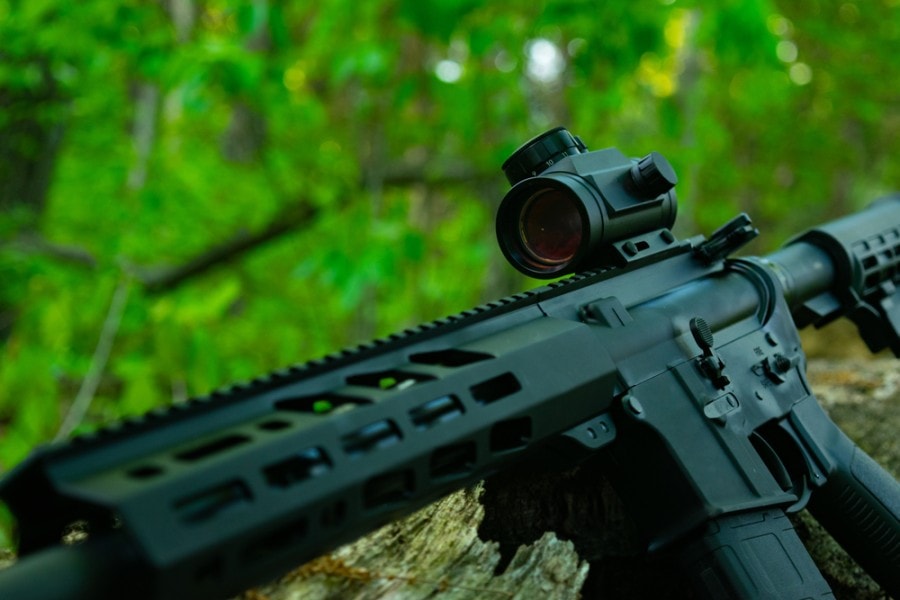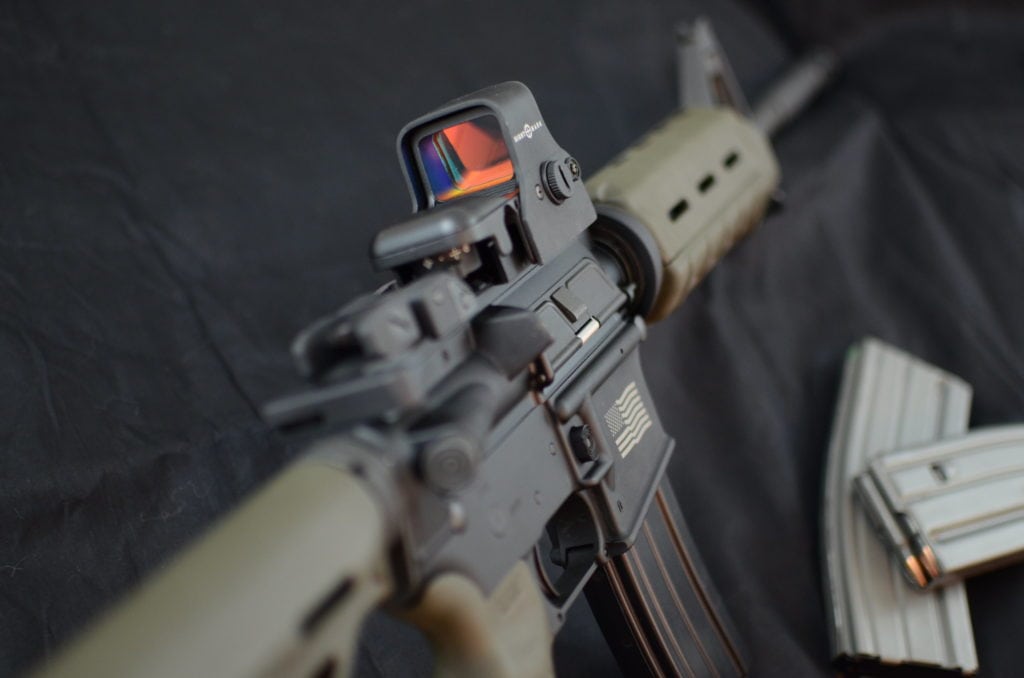Red Dot vs Holographic Sights: Which Is Better?
Last Updated on

Almost any sight with a red dot or other similar illuminated electronic aiming reticule can fall under the category of red dot sight. It’s a broad term that describes all these sights, even though there are many different types of red dot sights. Prism sights and reflex sights are both types of red dot sights. But one of the newest and most advanced types of red dot sights is the holographic sight.
Holographic sights represent a new level of technology compared to traditional red dot sights, which have been around for quite a while. But that doesn’t mean that holographic sights are always the best type of red dot sight for every situation. Let’s take a closer look at red dot vs holographic sights in general and see if a holographic sight is the right type of red dot sight for you.

What is a Red Dot Sight?

Red dot sights are any type of optic that uses a red dot or other similar illuminated reticle. There are three main types of red dot sights: prism sights, reflex sights, and holographic sights. For the rest of this section, we will talk about reflex sights and prism sights as compared to holographic sights, which we will cover in the next section.
Reflex and prism red dot sights can be very small and lightweight. In fact, some are even small enough to easily fit on handguns. They can also be very inexpensive, with the most expensive ones barely costing as much as the lowest-priced holographic sights.
Red dot sights tend to have very long-lasting battery lives. Some can even be left on for up to 50,000 hours on a single battery. This means that your weapon can be left at the ready without worry that the sight will be dead when you need it.
On the downside, most red dot sights that aren’t holographic have a two-MOA reticle. That’s twice the size of the reticle in a holographic sight. At 100 yards, a red dot sight reticle will cover two inches of your target while a holographic sight reticle will cover only an inch.
This effect will be amplified if you decide to add external magnification to your setup. If you magnify a two-MOA red dot reticle with 3X magnification, it is now six MOA. But since a holographic reticle is only one-MOA, it’s still just one-MOA when magnified 3X.
Since reflex red dot sights rely on the front lens to reflect the reticle back to the shooter, if the lens is damaged, the sight no longer functions. This is true of most types of sights. But the holographic sight escapes this flaw.
In the end, red dot sights are the better choice for those shopping on a budget and for anyone who wants the smallest and lightest sight with the longest battery life.
- Some are very affordable
- Some red dot sights are tiny
- Longer battery life
- If the lens is damaged, it’s no longer useful
- 2-MOA reticle isn’t great for magnifying
What is a Holographic Sight?

A holographic sight is a specific type of red dot sight that uses lasers and a series of mirrors to present a holographic reticle projection. These sights are made by only two companies: EOTech and Vortex. Although they are a type of red dot sight, holographic sights offer quite a few advantages over all the other types of red dot sights.
If you look downfield while using a holographic sight, the reticle will remain in focus. Try the same thing with other red dot sights and the reticle will become blurry and unfocused, making it much more difficult to reacquire your target. Since quicker aiming is always a benefit, this is a big advantage for holographic sights.
Another advantage is that holographic sights use a one-MOA reticle that stays at just one-MOA when magnified. This is much more accurate than other red dot sights that have a two-MOA reticle which multiplies in size when magnification is added.
If the front lens on a holographic sight is damaged or broken, the sight will still work. This makes a holographic sight infinitely more usable in real-world scenarios. Another great feature is that some of the higher-end holographic sights can even distance your target, performing range-finding duties for you.
Of course, none of this comes cheap. Entry-level holographic sights start where the top end of the red dot price range ends. If you want all the bells and whistles on your holographic sight, you could pay many times more than you’d spend on a high-end red dot sight.

Another downside to holographic sights is size and weight. They’re not necessarily bulky or heavy, but all that technology can only be compacted down to a certain size and weight. Compared to some of the tiny and ultra-lightweight red dot sights available, holographic sights do seem pretty cumbersome.
And don’t forget about battery life. Many holographic sights have a 500-hour battery life compared to 50,000 hours that many red dot sights offer. That’s a pretty significant difference and might be a deciding factor if you’re a person who always likes to have your weapon prepared .
Overall, holographic sights are the best choice for someone who wants a high-tech sight that’s always in focus, can work with a broken front lens, and allows for faster target acquisition. It’s also the better option for anyone who wants to add further magnification since holographic sights have a one-MOA reticle that doesn’t get larger when it’s magnified.
- Can operate with the front lens damaged
- Some can distance your target
- Remains in focus when looking down range
- Faster target acquisition
- 1-MOA reticle is better for magnifying
- Very expensive
- Bulkier and heavier
- Shorter battery life
- Only made by two companies

In Conclusion
In the end, it’s difficult to say which is better for either red dot sights or holographic sights. Each is better for particular situations, and they both have certain drawbacks as well.
Holographic sights are more expensive, bulkier, heavier, and have shorter battery life. But they also allow for faster target acquisition, they stay in focus when you look downrange, they can operate with the front lens broken, and some can even perform range-finding duties for you. They’re the best choice if you’re adding external modification, or if you want the fastest target acquisition possible.
Red dot sights aren’t as good for externally magnifying and they’re not usable if the front lens is damaged. But they’re much more affordable, smaller, lighter, and have an incredible battery life of 50,000 hours. They’re the better option if you want the smallest and lightest sight possible, or if you want to get a quality sight without breaking the bank.
Featured Image Credit: Santipong Srikhamta, Shutterstock
Table of Contents
About the Author Robert Sparks
Robert’s obsession with all things optical started early in life, when his optician father would bring home prototypes for Robert to play with. Nowadays, Robert is dedicated to helping others find the right optics for their needs. His hobbies include astronomy, astrophysics, and model building. Originally from Newark, NJ, he resides in Santa Fe, New Mexico, where the nighttime skies are filled with glittering stars.
Related Articles:
Binocular Magnification Chart: Numbers & Distances Compared
How to Clean a Refractor Telescope: Step-by-Step Guide
How to Clean a Telescope Eyepiece: Step-by-Step Guide
How to Clean a Rifle Scope: 8 Expert Tips
Monocular vs Telescope: Differences Explained (With Pictures)
What Is a Monocular Used For? 8 Common Functions
How to Clean a Telescope Mirror: 8 Expert Tips
Brightfield vs Phase Contrast Microscopy: The Differences Explained
